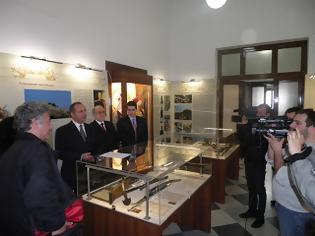Photo: naftemporiki.gr
If you are planning to visit Thessaloniki soon, you will have the opportunity to see the rare exhibition of relics from the period of the Greek liberation revolution in 1821. It displays the original swords and guns of the heroes of liberation – George Karaiskakis, Ioannis Makriyiannis and the original document of the "Society of Friends" (Φιλική Εταιρεία) with the signature of his leader Alexander Ypsilanti, which announced the beginning of the revolution.
 The exhibition is held at the Ministry of Macedonia-Thrace in Thessaloniki. It will be inaugurated on the day of the National Day of Greece, 25 March and will be open to citizens and tourists until 10 June this year. "With this exhibition, we want to shed light on the contribution of northern Greece in the revolutionary road of our nation in 1821, of which many people are unaware," says competent Minister Teodoris Karaoglou. He stresses that the revolutionary actions that started in Greek Macedonia were crucial for the liberation of the country and the historical exhibits included in the exhibition prove this thesis.
The exhibition is held at the Ministry of Macedonia-Thrace in Thessaloniki. It will be inaugurated on the day of the National Day of Greece, 25 March and will be open to citizens and tourists until 10 June this year. "With this exhibition, we want to shed light on the contribution of northern Greece in the revolutionary road of our nation in 1821, of which many people are unaware," says competent Minister Teodoris Karaoglou. He stresses that the revolutionary actions that started in Greek Macedonia were crucial for the liberation of the country and the historical exhibits included in the exhibition prove this thesis.
"The fact is that our ancestors from the northern regions of the country had built a protective "wall"  that prevented the numerous Turkish army from conquering south Greece. That is why they were liberated nearly 100 years before us," stresses the Minister of Macedonia-Thrace region in Greece. The exhibition organizers believe that the exhibition of the original exhibits from the Greek revival can help the Greeks remember the successes of their ancestors and draw national pride from the historic heroism of previous generations. The Minister also states, "History teaches us that we are capable of miracles when we are united. Together we can overcome the crisis more rapidly."
that prevented the numerous Turkish army from conquering south Greece. That is why they were liberated nearly 100 years before us," stresses the Minister of Macedonia-Thrace region in Greece. The exhibition organizers believe that the exhibition of the original exhibits from the Greek revival can help the Greeks remember the successes of their ancestors and draw national pride from the historic heroism of previous generations. The Minister also states, "History teaches us that we are capable of miracles when we are united. Together we can overcome the crisis more rapidly."
Vassilis Nikoltsos, director of the Museum of the Macedonian Army of Volunteers, notes, "Few people are aware that the Turkish army was decisively repulsed in Macedonia. This allowed the revolution to rise and spread in the Peloponnese, Thessaloniki, Halkidiki and in other areas. Entire villages in the region, which were wiped out, paid the price."